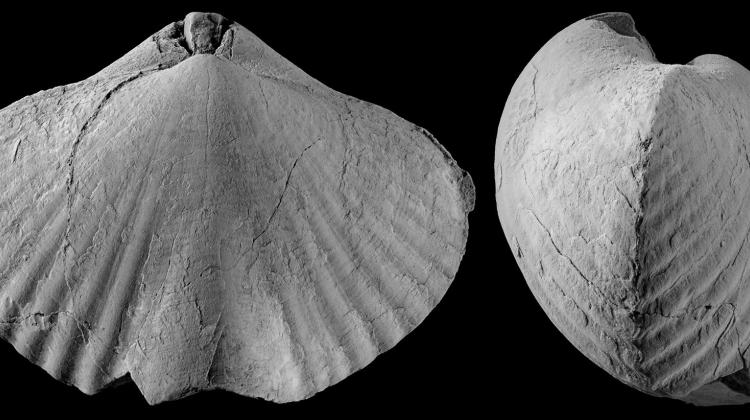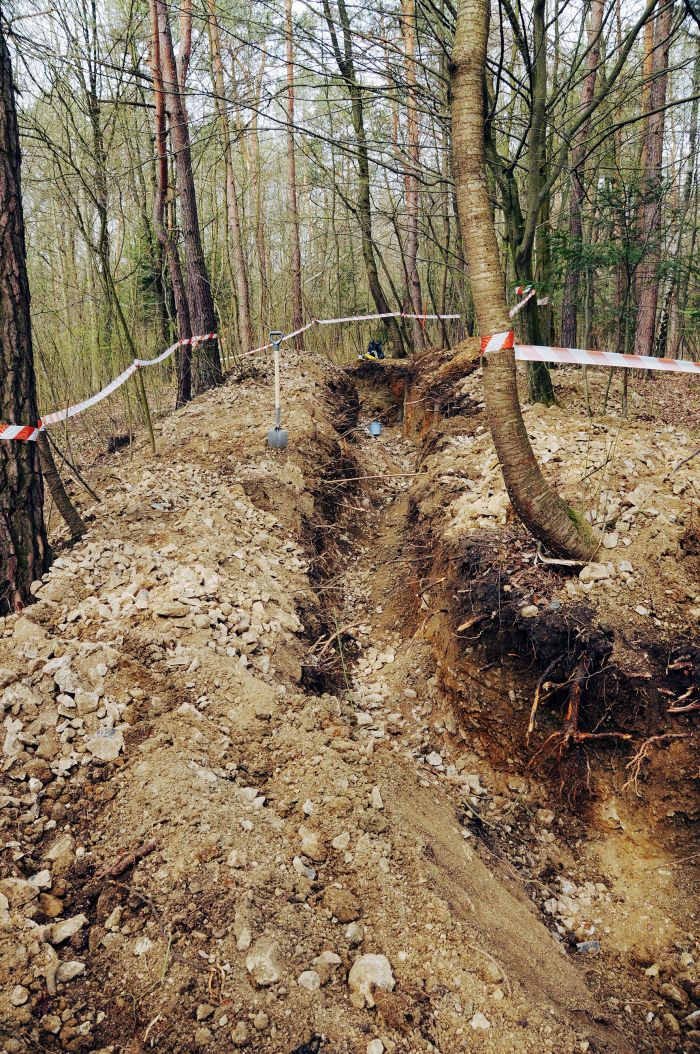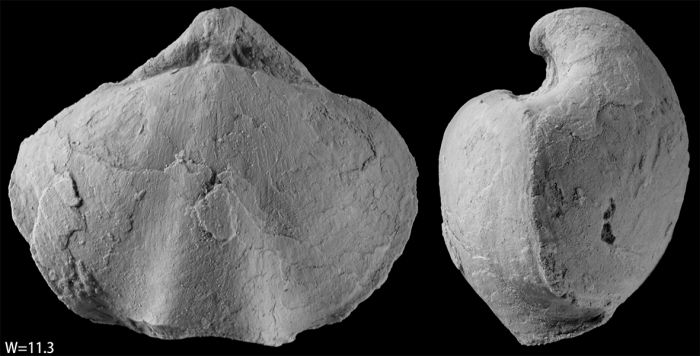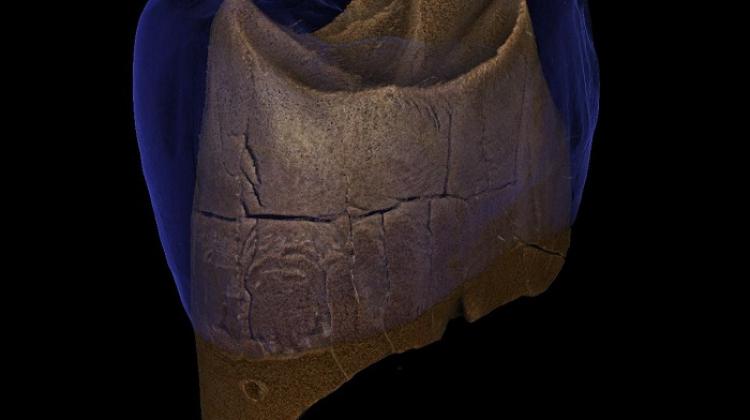Polish scientists discover three new species of brachiopods
 Undispirifer sidoniae Halamski et Baliński, 2023. Credit: Andrzej Baliński
Undispirifer sidoniae Halamski et Baliński, 2023. Credit: Andrzej Baliński
Polish paleontologists have discovered three new species of prehistoric brachiopods. Millions of years ago, these tiny marine invertebrates were among the most common animals of the seabed.
The monographic description of 68 brachiopod species, written by researchers from the Institute of Paleobiology of the Polish Academy of Sciences (Professor Andrzej Baliński and Dr. Adam Halamski) appeared in the journal Annales Societatis Geologorum Poloniae.
Brachiopods (Brachiopoda) are small marine invertebrates that live to this day. Their appearance is similar to mussels. In the Palaeozoic, they were among the most common animals on the seabed.
During the research conducted in Miłoszów (Świętokrzyskie Province), scientists identified and described three species new to science (including one species within the new genus) and named them. These are: Leiocyrtia rara (within a new genus named Leiocyrtia), Undispirifer sidoniae and Moravilla andreae. All three brachiopods belong to the order Spiriferida, characterized by a calcareous internal support for the lophophore (the main internal organ of brachiopods).

Dr. Halamski says that the new species were distinguished primarily on the basis of differences in shell ornamentation compared to related species. 'The genus Leiocyrtia is characterized by ornamentation so fine that it cannot be seen with the naked eye (hence the name - leios in Greek means 'smooth'). The species Moravilla andreae was named in honour of the recently deceased Andrzej Piotrowski, a palaeontologist, collector and museologist who discovered the first specimens of the new form. The name Undispirifer sidoniae commemorates the eighteenth-century poet Sidonia Zäunemann, who – unusually for those times - visited the mine and published its detailed verse description’, Halamski says.
Brachiopods are among the most commonly found fossils. 'Thanks to the chemical composition of their shells, we can reconstruct the temperatures of ancient oceans (and because these animals are still alive today, we know their physiology, unlike completely extinct groups such as trilobites and conodonts). Also, thanks to their shells, brachiopods are well preserved as fossils: it is the type of animals with the best fossil record in general. Therefore, any general evolutionary hypotheses should be tested on brachiopods, and for this you need to have the most detailed knowledge about their life in past epochs', says Halamski.
The research described in the paper is part of a larger project, financed by a grant from the Polish National Science Centre and devoted to the analysis of the impact of the so-called Taghanic event on the biosphere.
'The Taghanic event took place about 380 million years ago and was a marked period of mass extinction. Initial data indicated that the event was much more violent in North America than in Europe, so we decided to study this period in detail based on clusters of fossils from the Świętokrzyskie Mountains', adds Dr. Halamski.

The study site was Miłoszów, the fauna of which is dated to the period immediately preceding the Taghanic event, the palaeobiologist explains. 'It is a very rich set of organisms (about 200 species), of which brachiopods were the largest group (68 species). Thanks to the collected fossils and their multilateral (including geochemical) analysis, we were able to reconstruct the Devonian ecosystem - with small reefs , crinoid meadows and brachiopod meadows’, Halamski continues.
When reconstructing the underwater ecosystem, the scientists focused on its deeper layers. 'Shallow-water (reef - depth of about a dozen or so meters) ecosystems had already been known quite well, but we dealt with slightly deeper ecosystems (several dozen meters deep), which were less well known until now', says Dr. Halamski. 'In addition, one conclusion from our research was that the period of faunal development in the Świętokrzyskie Mountains was concurrent with the corresponding period in what is now New York State. This is quite important for future studies of the Taghanic event on a global scale.
'Middle Devonian faunas are quite well known; we described three new species out of 68, which is not much in palaeontology. I used to work on Triassic fauna (Triassic brachiopods are generally poorly known) and there among four species (it was small fauna) we described two new ones.’
He emphasises that many people have the misconception that the description of biodiversity on Earth, both modern and fossil one, is more or less complete. 'This is not true, new species are still being discovered. It so happens that I study not only brachiopods, but also botany. In 2019, I described a new species of buttercup (a modern-day flowering plant) found near Warsaw. Contrary to what many people claim, there is still a need for natural research at a very basic level, a systematic description of species. Even in well-known areas (central Europe) and well-known groups (flowering plants) you can find previously unknown things, you just need to know how to look. As far as the fossil biosphere is concerned, the state of knowledge about it is obviously much worse than that of the modern biosphere,’ Halamski says.

Moravilla andreae Baliński and Halamski, 2023. Credit: Andrzej Baliński
Research on brachiopods may also contribute to a better understanding of the phenomena accompanying global warming. For example, modern brachiopods are studied in the context of changes in the pH of seawater due to global warming and the consequences of these changes for the calcareous shell of brachiopods (a more acidic water dissolves calcium carbonate more quickly). 'Research on fossil brachiopods is an important part of learning about extinctions in past geological epochs; it is important for forecasting changes caused by the climate crisis, but remember that the time scale of current phenomena is incomparably faster than most phenomena known from the palaeontological record', says Dr. Halamski .
Find out more about the fossil ecosystem from Miłoszów on the website. (PAP)
Magdalena Barcz
bar/ zan/ kap/
tr. RL
Przed dodaniem komentarza prosimy o zapoznanie z Regulaminem forum serwisu Nauka w Polsce.
















